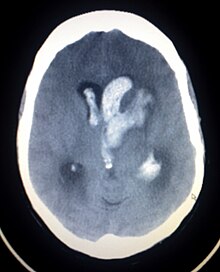
Back تغير مستوى الوعي Arabic Променено ниво на съзнание Bulgarian Quantitative Bewusstseinsstörung German تغییر سطح هوشیاری Persian Veranderd bewustzijnsniveau Dutch Nível de consciência alterado Portuguese การเปลี่ยนแปลงของระดับความรู้สึกตัว Thai
| Altered level of consciousness | |
|---|---|
 | |
| An intracranial hemorrhage, one cause of altered level of consciousness | |
| Specialty | Psychiatry, Neurology |
An altered level of consciousness is any measure of arousal other than normal. Level of consciousness (LOC) is a measurement of a person's arousability and responsiveness to stimuli from the environment.[1] A mildly depressed level of consciousness or alertness may be classed as lethargy; someone in this state can be aroused with little difficulty.[1] People who are obtunded have a more depressed level of consciousness and cannot be fully aroused.[1][2] Those who are not able to be aroused from a sleep-like state are said to be stuporous.[1][2] Coma is the inability to make any purposeful response.[1][2] Scales such as the Glasgow coma scale have been designed to measure the level of consciousness.
An altered level of consciousness can result from a variety of factors, including alterations in the chemical environment of the brain (e.g. exposure to poisons or intoxicants), insufficient oxygen or blood flow in the brain, and excessive pressure within the skull. Prolonged unconsciousness is understood to be a sign of a medical emergency.[3] A deficit in the level of consciousness suggests that both of the cerebral hemispheres or the reticular activating system have been injured.[4] A decreased level of consciousness correlates to increased morbidity (sickness) and mortality (death).[5] Thus it is a valuable measure of a patient's medical and neurological status. In fact, some sources consider level of consciousness to be one of the vital signs.[3][6]
- ^ a b c d e
Kandel E.R.; Jessell, Thomas M.; Schwartz, James H. (2000). Principles of neural science. New York: McGraw-Hill. pp. 901. ISBN 0-8385-7701-6. Retrieved 2008-07-03.
level of consciousness.
- ^ a b c Cite error: The named reference
Porth07was invoked but never defined (see the help page). - ^ a b Cite error: The named reference
Pollak02was invoked but never defined (see the help page). - ^ Porth, p. 838
- ^ Scheld et al.. p. 530
- ^ Forgey WW (1999). Wilderness Medicine, Beyond First Aid (5th ed.). Guilford, Conn: Globe Pequot. p. 13. ISBN 0-7627-0490-X. Retrieved 2008-07-04.